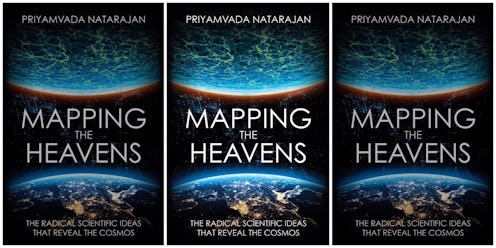Books
Need A Break From Fiction? Try These Science Books

Science writing is becoming more and more mainstream, a popular subject for layreaders to spend time with in a think piece or a pop science book. But for a long time, science writing (like everything else) was dominated by men. Thankfully, though, that’s quickly changing. From journalistic science writers to scientists who are able to write about their work with a clarity and simplicity required for non-scientists to understand to pop science, science writing is becoming more mainstream, and many of the people leading the way are women. Need proof? Here are nine science books written by women.
That doesn’t mean that science writing is primarily done by women; chances are still that if you pick up a random science book, it’ll be authored by a man. And if you ask someone to name a female science writer, they’ll come back with Mary Roach (who does excellent writing, and I recommend you check out her books if you haven’t, but I don’t want to recommend an author everyone is already familiar with). But there are so many other science writers who are women doing excellent work. The writers on this list (and many, many others who aren’t) have written excellent books ranging from cosmology to genetics to pandemics to astrophysics.
1'A Big Bang in a Little Room: The Quest to Create a New Universe' by Zeeya Merali
If you were going to create a brand new universe, what would you do? And how would you do it? That’s the journey science writer Zeeya Merali takes us on in her book Big Bang in a Little Room. What do we know about our universe’s beginnings? How can we apply that to a brand new universe that is (or one day will be) as complex as our own? This history of cosmology and our own beginnings asks some ambitious questions, and provides satisfying answers and clues along the way.
2'Venomous: How Earth’s Deadliest Creatures Mastered Biochemistry' by Christie Wilcox
What do creatures that have developed poisonous venom tell us about evolution? That’s what biologist Christie Wilcox discusses in her book Venomous. She takes us through a horror show of venomous animals that can kill or paralyze humans within minutes in all kinds of terrible ways, discussing how they developed these potent toxins and defense mechanisms. Wilcox also introduces readers to the brave scientists who study these deadly creatures, discussing the advances they are making every day.
3'Dark Matter and the Dinosaurs: The Astounding Interconnectedness of the Universe' by Lisa Randall
Is it possible that dark matter was actually responsible for the extinction of the dinosaurs? That’s what theoretical physicist Lisa Randall asks in her book on how our universe is more interconnected than we could ever possibly imagine. Randall’s central point is that everything in the universe is connected on the largest and smallest levels, which she discusses in an accessible and entertaining way.
4'The Sixth Extinction: An Unnatural History' by Elizabeth Kolbert
There have been five mass extinctions over the course of our planet’s history. Are we on the cusp of a sixth? Science writer Elizabeth Kolbert thinks that yes, we are, and it’s of our own making. Humans have irrevocably affected and changed the planet through our rampant use of fossil fuels. Human-caused climate change will lead to the sixth extinction of our planet, and it’s already started.
5'Mapping the Heavens: The Radical Scientific Ideas that Reveal the Cosmos' by Priyamvada Natarajan
Priyamvada Natarajan, a professor of astronomy and physics at Yale University, knows a thing or two about the discoveries that revealed the nature of our cosmos. Her book Mapping the Heavens is a “greatest hits” tour of the biggest and most interesting discoveries about the universe around us — and what’s to come in the next century and beyond.
6'Storm in a Teacup: The Physics of Everyday Life' by Helen Czerski
How is the physics of what we see around us in our world related to the cosmos? That’s the subject that Helen Czerski tackles in her book Storm in a Teacup. Her answer: Everything around us is connected. The physics of the carbonation in your soda or the kernels of corn you’re popping can tell us more about the universe around us. That’s why Czerski focuses on the physics of these smaller, seemingly mundane topics in her book—except these subjects aren’t mundane at all.
7'Pandemic: Tracking Contagions, from Cholera to Ebola and Beyond' by Sonia Shah
How does a pandemic develop? That’s what science writer Sonia Shah discusses in her latest book Pandemic. Scientists agree that it’s only a matter of time before a global pandemic occurs. How will it happen? By tracking cholera’s journey and analyzing viruses like MRSA and Ebola, Sonia Shah hopes to provide some answers and shine some light on what this virus might look like.
8'Black Hole Blues and Other Songs from Outer Space' by Janna Levin
For decades, scientists have theorized that when two black holes collide, they emanate waves in the shape of spacetime itself: gravitational waves. In late 2015, LIGO (the Laser Inferometer Gravitational-Wave Observatory) confirmed this theory when they detected gravitational waves. Astrophysicist Janna Levin takes us on a fascinating (and accessible!) history through the hunt for gravitational waves, the quirky personalities involved, and what they mean for our universe.
9'The Epigenetics Revolution: How Modern Biology is Rewriting Our Understanding of Genetics, Disease, and Inheritance' by Nessa Carey
Epigenetics is the study of how we’re affected by changes to the way our genes express themselves, rather than changes in the genes themselves, and scientists are realizing that they are more important than they ever suspected. It’s changing the way biologists approach the human gene and genetics, and Carey explains it clearly (for non-scientists!) in this important work.